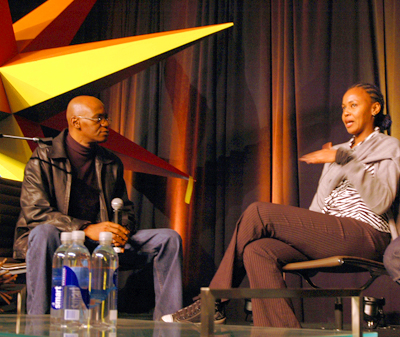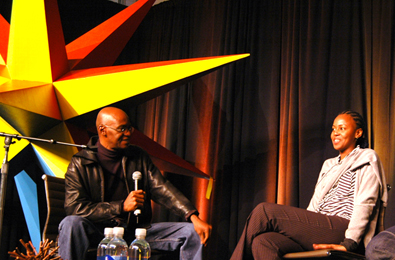Conversations with Contemporary Artists
October 27, 2007
DENVER ’Äì The facilitator, Dr. Moya Okediji, asked Wangechi Mutu if she had decided to draw on the walls of the Museum of Contemporary Art because she was expressing the traditional art of women in Africa. Sculpture, Okediji said, is what is sexistly shown in most museums of African art because sculpture is traditionally made by men, and women, he said, paint.
Mutu is one of seven ’ÄúStar Power’Äù artists in the opening exhibition in the new Museum of Contemporary Art, Denver, which opens to the public Oct. 28.
Mutu was visibly surprised by the question, and looked within herself for the answer. She had just said her work at this museum, building a landscape that poured from the walls, was a departure from collage, which is her more well-known work.
Mutu was regretful, but tough, when she answered she’Äôd not received training in the traditional arts of her tribe. She was educated instead in an urban, Catholic school in Nairobi because her grandmother had bought into the Christian thing ’Äì the British did their job well on her ’Äì she said. Mutu, who lives in New York, said she had to leave Kenya to be free to be taken seriously as a contemporary woman artist.
 The MCA chose the scholarly moderator, professor at the University of Colorado Dr. Okediji to pose questions to Mutu and paired her with Rangi Kipa, a New Zealand artist. Kipa had been trained in traditional Maori carving crafts before going to university to study anthropology. Kipa told me he feels pressured to be almost a factory of traditional crafts and has had to struggle to be given the time and encouragement to be a contemporary artist ’Äì to find his independence in his own time.
The MCA chose the scholarly moderator, professor at the University of Colorado Dr. Okediji to pose questions to Mutu and paired her with Rangi Kipa, a New Zealand artist. Kipa had been trained in traditional Maori carving crafts before going to university to study anthropology. Kipa told me he feels pressured to be almost a factory of traditional crafts and has had to struggle to be given the time and encouragement to be a contemporary artist ’Äì to find his independence in his own time.
The MCA set up this series of paired conversations on the Saturday before the official opening day of the new exhibition: Museum as Body Electric at the MCA’Äôs new-as-fresh-paint building designed by London architect David Adjaye. Meanwhile, Coors Field, blocks away, was filling up for the first ever home game of Colorado’Äôs first World Series.
The drama continued. New York University professor John Torreano pitched questions to artists Collier Schorr and Candice Breitz, getting both to reveal how much each was able to get out of their subjects. Schorr said Jens, the adolescent boy in her series about Andrew Wyeth poses, had no interests in even speculating about whether or not Wyeth had an affair with Helga his model, and so the photos reflex a clearly defined, emotionless relationship which is part of the ’Äúbiography’Äù Schorr said she was interested in portraying. Breitz filmed average Bob Marley fans singing along, by themselves, with Marley's songs, same setting, same songs. Breitz said she was amazed by how different participant performed, and this appears in her video installation.
David Altmejd was interviewed by Miami artist Roberto Behar regarding his fantasy ’Äúgiant’Äô sculptures made of mirrors in a mirrored room. Behar said he was fascinated and, at the same time, made uneasy by the room, and Altmejd, curious, then interviewed his viewer. Behar said the space made him feel like a kid in the fun house, and he almost recreated the nervous laughter that goes with that feeling. The discussion returned to the idea of overwhelming with fantasy: Behar with color reminiscent of his Argentinean childhood, which he included in the interior design for the gala tent used by the MCA this weekend, and Altmejd with mirrors, mirrors, everywhere, so pervasive that the giants seemed like they might disappear into the sameness of the room, disappear like a spirit. Sure, he said, you get the idea that the room suggests self reflection, but the big mythology is continuously bent, split and fractured like the crystalline forms assembled to create them. And really, Altmejd said, they are just pure fantasy figures.
Terry Talty is an art tourist writing about contemporary art wherever it exists. Return to the Art Tourist visits the Body Electric, Museum of Contemporary Art Denver.